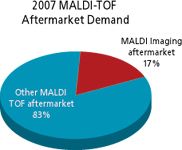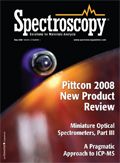Market Profile: MALDI Imaging
The adoption of MALDI-TOF mass spectrometry for imaging applications is a major recent development in the market. Applications lie squarely in the life sciences area, being primarily in histopathology. The market for MALDI imaging products already accounts for a significant and rapidly growing portion of the aftermarket for MALDI-TOF mass spectrometry.
The adoption of MALDI-TOF mass spectrometry for imaging applications is a major recent development in the market. Applications lie squarely in the life sciences area, being primarily in histopathology. The market for MALDI imaging products already accounts for a significant and rapidly growing portion of the aftermarket for MALDI-TOF mass spectrometry.

Samples for MALDI imaging are normally prepared using a microtome, and then are coated with matrix. The sample can then be analyzed directly via a MALDI interface, which allows the retention of spatial information. Commercial products for MALDI-TOF imaging, including software and sample preparation equipment, first became widely available within the past five years. While manual sample preparation, which was initially widely used, is quite inexpensive, it requires a significant level of skill, and even then is not particularly reproducible. Over the past several years, there have been a number of automated sample preparation systems introduced that automatically apply matrix to the sample, thus significantly improving reproducibility. One of the biggest advantages of MALDI-TOF imaging over other imaging techniques is that dying and tagging generally are not required, making the MALDI-TOF method simpler, and relatively inexpensive.
Applications for MALDI-TOF lie in the life sciences, and are primarily histological and pathological in nature. Both plant and animal tissue sections can be analyzed for the distribution of specific drug compounds and their metabolites, which is currently the largest area of application. MALDI-TOF imaging also can be used to identify the distribution of proteins and biomarkers, but such application is less widespread.
The combined market for MALDI-TOF imaging products amounted to less than $10 million in 2007, not including the mass spectrometers themselves, but still makes up a significant percentage of the aftermarket. The rapid growth of MALDI imaging products is also largely responsible for driving the growth of the aftermarket for MALDI-TOF mass spectrometry.
The foregoing data were based on SDi's market analysis and perspectives report entitled Mass Spectrometry, February 2008. For more information, contact Stuart Press, Senior Consultant, Strategic Directions International, Inc., 6242 Westchester Parkway, Suite 100, Los Angeles, CA 90045, (310) 641-4982, fax: (310) 641-8851, www.strategic-directions.com.

High-Speed Laser MS for Precise, Prep-Free Environmental Particle Tracking
April 21st 2025Scientists at Oak Ridge National Laboratory have demonstrated that a fast, laser-based mass spectrometry method—LA-ICP-TOF-MS—can accurately detect and identify airborne environmental particles, including toxic metal particles like ruthenium, without the need for complex sample preparation. The work offers a breakthrough in rapid, high-resolution analysis of environmental pollutants.
The Fundamental Role of Advanced Hyphenated Techniques in Lithium-Ion Battery Research
December 4th 2024Spectroscopy spoke with Uwe Karst, a full professor at the University of Münster in the Institute of Inorganic and Analytical Chemistry, to discuss his research on hyphenated analytical techniques in battery research.
Mass Spectrometry for Forensic Analysis: An Interview with Glen Jackson
November 27th 2024As part of “The Future of Forensic Analysis” content series, Spectroscopy sat down with Glen P. Jackson of West Virginia University to talk about the historical development of mass spectrometry in forensic analysis.
Detecting Cancer Biomarkers in Canines: An Interview with Landulfo Silveira Jr.
November 5th 2024Spectroscopy sat down with Landulfo Silveira Jr. of Universidade Anhembi Morumbi-UAM and Center for Innovation, Technology and Education-CITÉ (São Paulo, Brazil) to talk about his team’s latest research using Raman spectroscopy to detect biomarkers of cancer in canine sera.